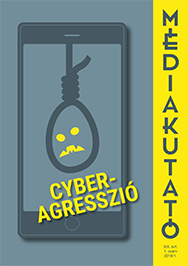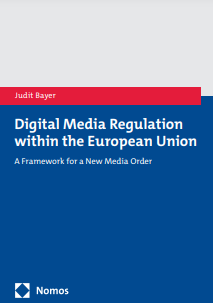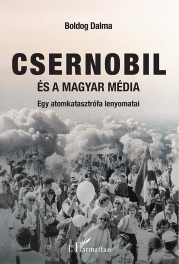Contents – Spring 2018
Sorbán, Kinga:
Sorbán, Kinga:
Current issues of the European regulation of video-sharing platforms
New media services constitute an ever growing part of users’ content consumption and of the media market. In parallel with the increasing popularity of video-sharing platforms, services that are not audiovisual media services and yet facilitate the establishment of a link between the audiovisual content and the user need to be defined and placed within the system of European audiovisual regulation. On 25 May 2016, the European Commission published its proposal for the modification of the Audiovisual Media Services Directive which defines video-sharing platform services as a new type of services. This form of service is unknown in both the European and the Hungarian media regulations, therefore the notion raises several questions and challenges for both legislators and professionals. This study aims at clarifying how the term video-sharing platform can be defined, where its place in the audiovisual media value chain is, and describes what rules are anticipated to be enforced as part of the revision of the European regulation.
Current issues of the European regulation of video-sharing platforms
Médiakutató Spring 2018 pp. 9-20
Zsila, Ágnes – Demetrovics, Zsolt:
Zsila, Ágnes – Demetrovics, Zsolt:
Cyber-victimisation and cyber-aggression
Cyberbullying (online bullying), defined as a repeated, intended act of aggression via electronic devices, has been an area of emerging research interest due to its negative psychological consequences. However, relatively little research has focused on the association between cyberbullying experiences and social networking sites use. The aim of this study was to identify the most prevalent forms of cyberbullying, and to explore the associations of internet use and social networking sites use with cyberbullying experiences on a sample of adolescent and adult social networking sites users (N = 1500; 57.9% male; Mage = 28.9 years, SD = 8.7). It found that perpetrators preferred mostly public forms of bullying (e.g., flaming and exclusion), whereas victims often experienced both public and private forms (e.g., harassment). Victimisation was best predicted by perpetrator experiences, whereas perpetration was best predicted by victimisation. Victims were more likely to be female, older, active users of several social networking sites, pursued more cautious privacy protection strategies, and reported having more psychiatric symptoms than those who did not report of any cyberbullying experiences. In contrast, perpetrators were more likely to be male, younger, spent more time on the internet, and knew fewer friends personally of their confirmed contacts on social networking sites. These findings may contribute to the efficacy of prevention and intervention programmes.
Cyber-victimisation and cyber-aggression
Médiakutató Spring 2018 pp. 21-33
Baksa, Máté:
Baksa, Máté:
Enterprise Social Media as a platform for internal publicity: definitions and metaphors
Investigation on the effects of Enterprise Social Media is an increasingly popular subfield of both social media research and the management of information systems. The author examines the subject from a managerial point of view with a professional background in organisation and management. This study is aimed at presenting various definitions and metaphors describing Enterprise Social Media as well as at accentuating its importance in an organisational context. The author introduces distinctive user patterns and cultural and behavioural norms in Enterprise Social Media based on the findings of his qualitative research in a company operating in a knowledge-intensive industry in Hungary.
Enterprise Social Media as a platform for internal publicity: definitions and metaphors
Médiakutató Spring 2018 pp. 37-49
Tófalvy, Tamás:
Tófalvy, Tamás:
Content consumption patterns and user attitudes in the Facebook-dominated Hungarian digital media ecosystem
Facebook has become the most important content distributor platform globally, thus in the Hungarian digital media ecosystem as well. The relationship between the platform, which functions as the largest aggregator platform next to Google, and ‘traditional’ online media companies (content providers) is particularly controversial. Based on the data made available by two recent Hungarian research projects and a comparison of these with international research findings, this paper looks at two specific areas. One the one hand, it asks the question of what the main trends are in content sharing and interactions on Facebook and what conclusions could be drawn from these trends. On the other hand, that of what users’ attitudes are towards content consumption on Facebook, and what effect Facebook may have on the perception of content providers’ brands and content. The data on Hungarian Facebook content consumption patterns is mainly derived from two research projects which were commissioned by the Association of Hungarian Content Providers, funded by the Media Council of the National Media and Infocommunications Authority, and carried out by NRC Research and lyZR.
Médiakutató Spring 2018 pp. 51-65
Babarczy, Eszter:
Babarczy, Eszter:
The Öcsény debate on Facebook: A content analysis
This paper examines Facebook debates on a Hungarian news story about the resistance of Hungarian villagers to an NGO’s initiative to offer refugees a few days’ rest in a village inn. It focuses on evidence of selective exposure along political lines and the degree of polarisation. The content analysis shows a considerable overlap between audiences of news sources critical of and loyal to the government. Participants engage in dialogue, even though their comments are emotional and highly polarised. A short questionnaire was also addressed to participants, asking them to evaluate the debate. It found that they resented polarisation and attributed it to the impact of political elites and the media.
The Öcsény debate on Facebook: A content analysis
Médiakutató Spring 2018 pp. 67-75
Hlavacska, András:
Hlavacska, András:
Dracula and the media – in the mirror of two contemporary vampire films
In Bram Stoker’s novel on Dracula, almost all media from the phonograph through the typewriter to the telegraph that were considered modern in the 1890s are present. A number of analyses have been published on this topic since the 1980s with a focus on the functions and the symbolic meaning of these media. These writings represent Count Dracula as an atavistic, primitive creature and agree that modern media make a significant contribution to the defeat of the vampire. This paper looks at how contemporary vampire movies tackle this issue. It, first, offers and overview of this legacy, then an analysis of two contemporary vampire films (What We do in the Shadows, 2014; Shadow of the Vampire, 2000) arguing that, on one hand, these depict vampires as atavistic creatures who can hardly use modern media, while on the other hand, these movies also show the vampire-like face of these media. Finally, it shows that a similar paradox can also be found in Stoker’s original writing.
Dracula and the media – in the mirror of two contemporary vampire films
Médiakutató Spring 2018 pp. 79-89




